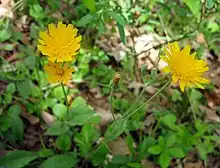| Krigia biflora | |
|---|---|
 | |
| Scientific classification | |
| Kingdom: | Plantae |
| Clade: | Tracheophytes |
| Clade: | Angiosperms |
| Clade: | Eudicots |
| Clade: | Asterids |
| Order: | Asterales |
| Family: | Asteraceae |
| Genus: | Krigia |
| Species: | K. biflora |
| Binomial name | |
| Krigia biflora | |
| Synonyms[1] | |
| |
Krigia biflora, also known as two-flower cynthia or two-flower dwarf dandelion, is a species of plant in the family Asteraceae. It is native to North America, where it is found in central Canada (Manitoba and Ontario) and in the eastern, central, and southwestern United States.[2][3] This species is rare in Connecticut, and it is listed as a species of special concern.[4]
Krigia biflora is an erect perennial growing 450–800 mm (18–31 in) tall. One plant can have 20 or more flower heads, very often two per flower stalk, each head with 25–60 yellow to orange-yellow ray flowers about 25–40 mm (1–1+1⁄2 in) across. There are no disc flowers. It can be an aggressively spreading plant. It grows in a variety of habitats and soils and blooms in late spring to late summer. The name of the plant consists of two words: Krigia for David Krieg, the German physician who first collected this plant in Maryland; and biflora, meaning two-flowered.[5][6] Its habitats include streams, meadows, and moist prairies.[6]
References
- ↑ The Plant List, Krigia biflora (Walter) S.F.Blake
- ↑ United States Department of Agriculture plants profile
- ↑ Biota of North America Program 2014 county distribution map
- ↑ Connecticut Botanical Society
- ↑ Wisconsin Plants Archived 2013-05-24 at the Wayback Machine
- 1 2 Flora of North America, Krigia biflora (Walter) S. F. Blake, 1915. Orange dwarfdandelion
